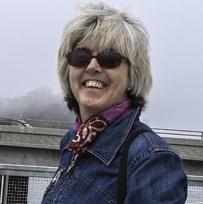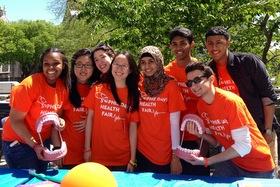
Theresa Montini, assistant medical professor, Sophie Davis School of Biomedical Education

Sophie Davis dental students at a campus health fare: (Left to right) Shari Williams, Sangmee Kim, Helena Kennedy, Nancy Mo, Yumna Piracha, Nithin Thmpi, Avi Ariyev and Imran Ahmed.
Nearly half needing to see a dentist don’t go due to financial, transportation or support network issues, study led by Sophie Davis professor finds
Nearly nine out of 10 older adults may need urgent dental care, however, just over half will see a dentist in a timely manner, a study of residents in naturally occurring retirement communities in New York City finds. Affordability, transportation and organizational issues were the biggest barriers to treatment, said lead author Theresa Montini, an assistant medical professor at The City College of New York’sSophie Davis School of Biomedical Education.
Of the 184 senior center attendees examined by faculty and student dentists, 89 percent needed dental treatment. The team followed 105 of those originally screened to see whether they got the necessary care. Just over half – 52 percent – saw a dentist within three months of the initial exam.
Professor Montini and her team then interviewed 35 of the 50 seniors who did not get needed care. In 60 percent of cases, financial constraint was the reason given; 31 percent of respondents cited poor transportation, and 20 percent said they lacked someone to help them make an appointment, get to the dentist or navigate the dental care system.
Those who didn’t see a dentist because of financial issues had fewer teeth and were more likely to need a set of dentures or have dentures repaired, Professor Montini noted. The $3,000 cost for a complete set of dentures was beyond the means of those lacking dental insurance.
Professor Montini suggested including dental care coverage in Medicare could address the problem. Most of the study participants had incomes above the ceiling for Medicaid, which covers dental care, but could not afford private dental insurance.
Savings on other health issues could offset some of the cost of expanding Medicare. Researchers, including City College Provost Maurizio Trevisan, have associated periodontal disease with problems such as cardiovascular disease, respiratory disease and poor control of diabetes. A study of Oregon’s Medicaid system found overall costs rose when dental coverage was discontinued. Dental care coverage was restored subsequently, resulting in overall healthcare cost savings.
A possible remedy to transportation issues would be organizing vanpools from neighborhood senior centers, she noted. Senior center nurses or social workers could help elderly residents make appointments and obtain transportation. Changing licensing requirements to enable nurses and dental hygienists to perform exams outside of dental clinics and refer patients to dentists could make getting dental care easier for older adults.
The Sophie Davis School trains health care providers to serve medically underserved populations, which include the elderly under U.S. Health Resources and Services Administration definitions. Currently, eight Sophie Davis students are preparing to become dentists and work in underserved communities.
About The City College of New York
Since 1847, The City College of New York has provided low-cost, high-quality education for New Yorkers in a wide variety of disciplines. More than 16,000 students pursue undergraduate and graduate degrees in: the College of Liberal Arts and Sciences; the Bernard and Anne Spitzer School of Architecture; the School of Education; the Grove School of Engineering; the Sophie Davis School of Biomedical Education, and the Colin Powell School for Civic and Global Leadership. U.S. News, Princeton Review and Forbes all rank City College among the best colleges and universities in the United States.
About The Sophie Davis School of Biomedical Education
Since 1973, the Sophie Davis School of Biomedical Education has offered a unique, seven-year BS/MD program that integrates an undergraduate education with the first two years of medical school. After five years, students transfer seamlessly to a cooperating medical school for the final two years. In addition, Sophie Davis offers a physician assistant program in partnership with Harlem Hospital Center that leads to a BS degree. The PA program began in 1970 and the affiliation with CCNY and Sophie Davis began in 1978. The school's mission is to increase accessibility to careers in medicine for underrepresented groups and to train primary care health care professionals to serve in medically underserved communities. Around 46 percent of its approximately 460 PA and BS/MD students are African-American or Hispanic.